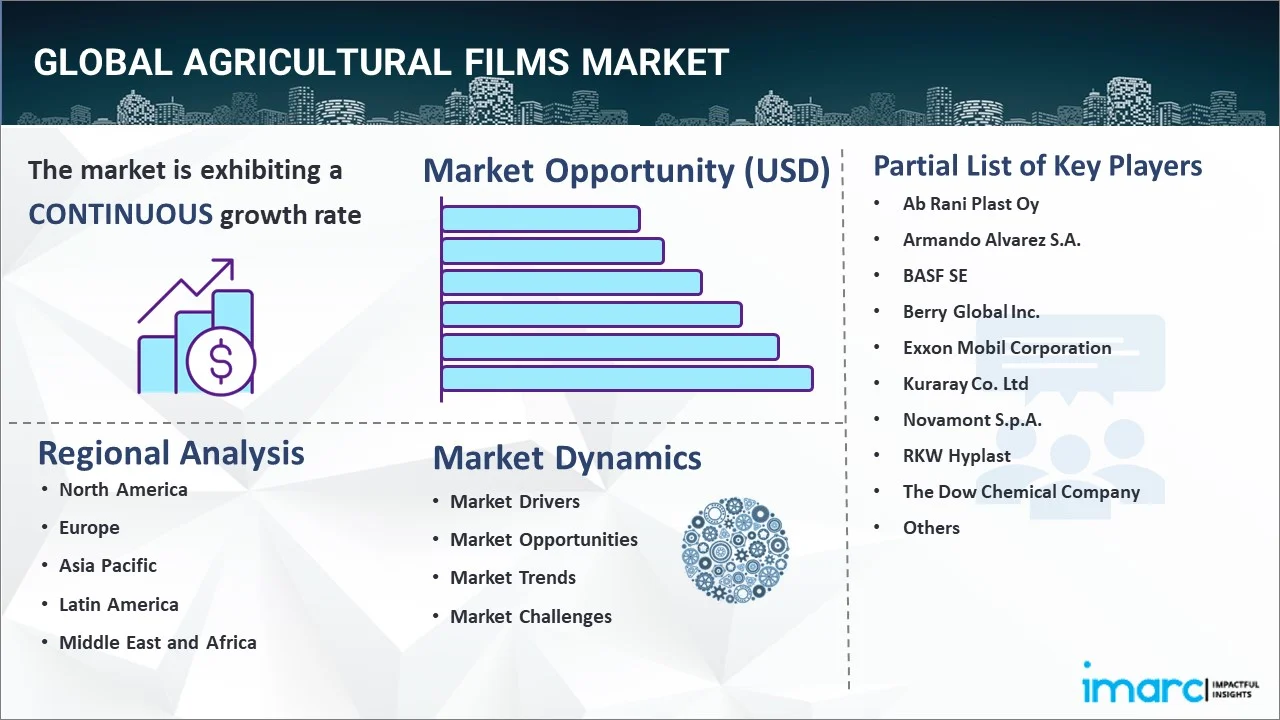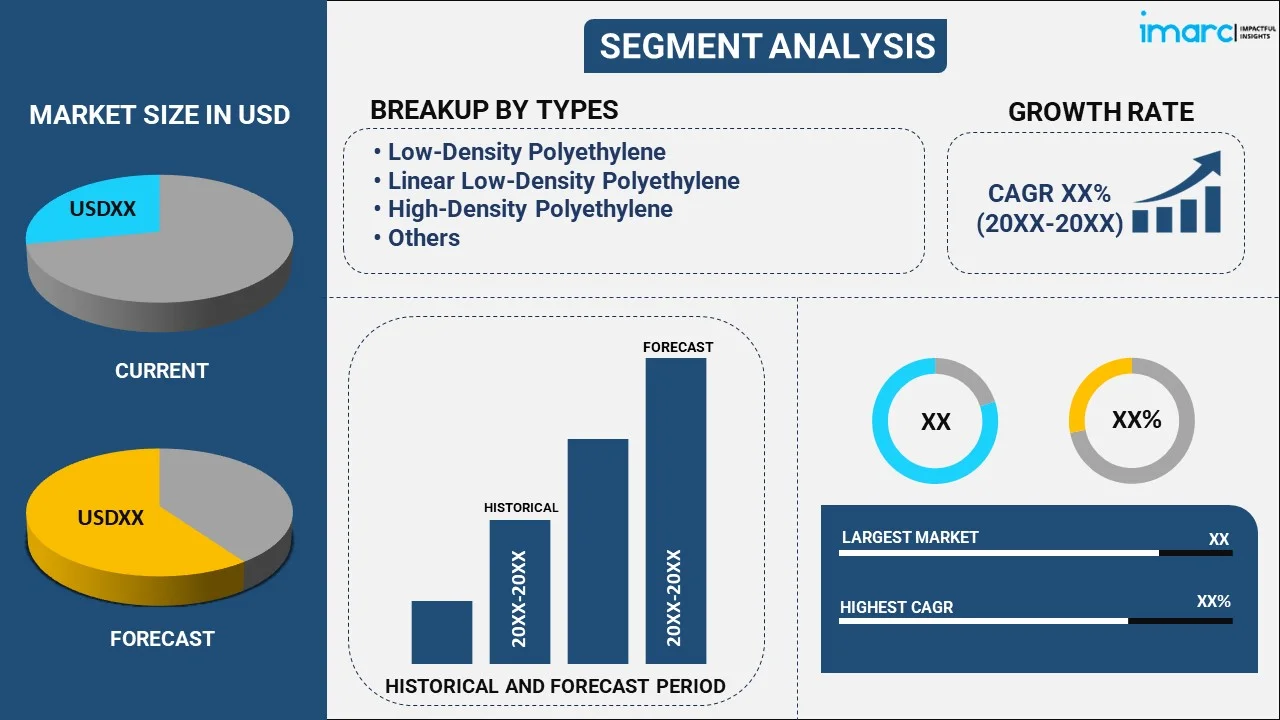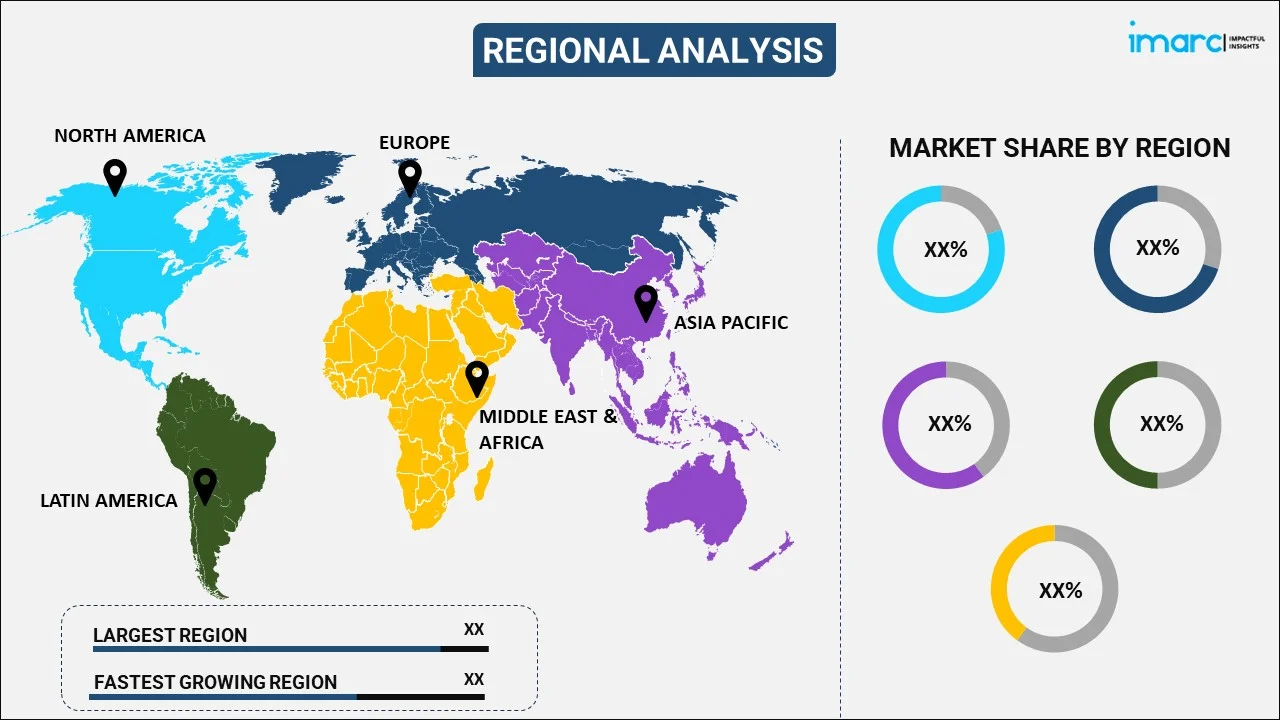
Agricultural Films Market Report by Type (Low-Density Polyethylene, Linear Low-Density Polyethylene, High-Density Polyethylene, Ethylene Vinyl Acetate, and Others), Application (Greenhouse, Silage, Mulching, and Others), and Region 2025-2033
Global Agricultural Films Market:
The global agricultural films market size reached USD 11.7 Billion in 2024. Looking forward, IMARC Group expects the market to reach USD 18.2 Billion by 2033, exhibiting a growth rate (CAGR) of 4.78% during 2025-2033. The rising number of policies by government bodies to promote modern farming techniques is stimulating the market demand. At present, Asia Pacific holds the largest market share, driven by rapid developments in the agriculture sector.
|
Report Attribute
|
Key Statistics
|
|---|---|
|
Base Year
|
2024 |
|
Forecast Years
|
2025-2033
|
|
Historical Years
|
2019-2024
|
| Market Size in 2024 | USD 11.7 Billion |
| Market Forecast in 2033 | USD 18.2 Billion |
| Market Growth Rate 2025-2033 | 4.78% |
Agricultural Films Market Analysis:
- Major Market Drivers: The growing focus on reducing water consumption, facilitating better crop management, and protecting plants from adverse weather conditions is propelling the market.
- Key Market Trends: The inflating popularity of mulching and greenhouse cultivation is acting as a significant growth-inducing factor transforming the agricultural films market outlook.
- Competitive Landscape: Some of the major market companies include Ab Rani Plast Oy, Armando Alvarez S.A., BASF SE, Berry Global Inc., Exxon Mobil Corporation, Kuraray Co. Ltd, Novamont S.p.A., RKW Hyplast, The Dow Chemical Company, and Trioplast Industrier AB, among many others.
- Geographical Trends: Numerous subsidiaries by regulatory authorities, coupled with the escalating food demand, are augmenting the market in Asia Pacific.
- Challenges and Opportunities: The environmental impact of plastic waste is hampering the market. However, developing recycling technologies will continue to catalyze the market over the forecasted period.

Agricultural Films Market Trends:
Adoption of Biodegradable Variants
The growing emphasis on sustainability is prompting a shift towards biodegradable alternatives. This trend is gaining popularity as regulatory pressures increase and farmers seek eco-friendly solutions to reduce their environmental footprint. In July 2024, BASF developed Tinuvin NOR 211 AR to support film converters and producers globally in navigating the use of plastic materials in agricultural applications. This new high-performance heat and light stabilizer protects and prolongs the lifespan of agricultural plastics that require resistance to high levels of inorganic chemicals like chlorine and sulfur. Tinuvin NOR 211 AR also provides an effective value-in-use solution for agricultural plastics exposed to intense thermal stress, UV radiation, and inorganic chemicals commonly used in crop management and disinfection. This is increasing the agricultural films market value.
Elevating Use of Smart Technologies
Farmers seek to optimize crop production via advanced technologies. Smart films are specifically designed with embedded sensors or responsive materials that can regulate light, temperature, and humidity levels within greenhouses or open fields. In March 2024, the Central Tuber Crops Research Institute (CTCRI), an Indian Council of Agricultural Research (ICAR) facility, introduced e-crop, an Internet of Things (IoT) device for smart farming. It stimulates crop growth in real-time based on soil moisture, nutrient status, and weather. This represents agricultural films market price trends.
Widespread Popularity of Waste Regulations
Agricultural films provide benefits like reduced labor costs and improved soil health, as they eliminate the need for disposal after use and removal. Manufacturers are responding to this demand by launching new formulations that balance durability with biodegradability, thereby meeting both agricultural performance requirements and sustainability goals. In March 2024, Berry Global’s European flexible films division showcased its latest developments in agricultural films and pouches at three events hosted by Applied Market Information Ltd. (AMI) in Barcelona and Valencia, Spain.
Global Agricultural Films Industry Segmentation:
IMARC Group provides an analysis of the key trends in each segment of the market, along with the agricultural films market forecast at the global, regional, and country levels for 2025-2033. Our report has categorized the market based on type and application.
Breakup by Type:

- Low-Density Polyethylene
- Linear Low-Density Polyethylene
- High-Density Polyethylene
- Ethylene Vinyl Acetate
- Others
Linear low-density polyethylene currently holds the largest agricultural films market share
The report has provided a detailed breakup and analysis of the market based on the type. This includes low-density polyethylene, linear low-density polyethylene, high-density polyethylene, ethylene vinyl acetate, and others. According to the report, linear low-density polyethylene represented the largest market segmentation.
Linear low-density polyethylene agricultural films gained traction, owing to their excellent flexibility, durability, and cost efficiency, which makes them a preferred choice for several agricultural applications like silage wraps. This is elevating the agricultural films market statistics.
Breakup by Application:
- Greenhouse
- Silage
- Mulching
- Others
Mulching currently holds the largest agricultural films market demand
The report has provided a detailed breakup and analysis of the market based on the application. This includes greenhouse, silage, mulching, and others. According to the report, mulching represented the largest market segmentation.
Agricultural films for mulching have become important tools for modern farming, offering benefits, such as improved weed suppression, moisture retention, and enhanced soil temperature regulation. Moreover, they create a controlled environment for crops, thereby leading to more efficient water usage and higher yields. Apart from this, leading companies, including BASF and Novamont, developed biodegradable mulching films that aid in reducing plastic waste and environmental impact, thereby elevating the agricultural films market revenue.
Breakup by Region:

- North America
- United States
- Canada
- Europe
- Germany
- France
- United Kingdom
- Italy
- Spain
- Russia
- Others
- Asia Pacific
- China
- Japan
- India
- South Korea
- Australia
- Indonesia
- Others
- Latin America
- Brazil
- Mexico
- Others
- Middle East and Africa
Asia Pacific currently dominates the market
The agricultural films market research report has also provided a comprehensive analysis of all the major regional markets, which include North America (the United States and Canada); Europe (Germany, France, the United Kingdom, Italy, Spain, Russia, and others); Asia Pacific (China, Japan, India, South Korea, Australia, Indonesia, and others); Latin America (Brazil, Mexico, and others); and the Middle East and Africa. According to the report, Asia Pacific accounted for the largest agricultural films market share.
As per the agricultural films market segmentation, Asia Pacific exhibits a clear dominance in the market driven by the region's expanding agricultural sector and increasing demand for food production. Furthermore, Toray and Ginegar, some of the prominent brands, are introducing innovative products like multi-layered films that offer superior durability and climate control.
Competitive Landscape:
As per the agricultural films market overview, major companies across the globe in the market are introducing strategic initiatives to fortify and enhance their positions within this competitive landscape. They are also investing significantly in research and development (R&D) to innovate and develop advanced agricultural films, including films with improved properties such as enhanced ultraviolet (UV) protection, better biodegradability, and optimized light transmission.
The market research report has provided a comprehensive analysis of the competitive landscape. Detailed profiles of all major market agricultural films companies have also been provided. Some of the key players in the market include:
- Ab Rani Plast Oy
- Armando Alvarez S.A.
- BASF SE
- Berry Global Inc.
- Exxon Mobil Corporation
- Kuraray Co. Ltd
- Novamont S.p.A.
- RKW Hyplast
- The Dow Chemical Company
- Trioplast Industrier AB
(Please note that this is only a partial list of the key players, and the complete list is provided in the report.)
Agricultural Films Market Recent Developments:
- July 2024: BASF developed Tinuvin NOR 211 AR, a new high-performance heat and light stabilizer, to support agricultural films converters and producers globally in navigating the use of plastic materials.
- March 2024: Berry Global’s European flexible films division showcased its latest developments in agricultural films and pouches at three events hosted by Applied Market Information Ltd. (AMI) in Barcelona and Valencia, Spain.
- March 2024: The Central Tuber Crops Research Institute (CTCRI), an Indian Council of Agricultural Research (ICAR) facility, introduced e-crop, an Internet of Things (IoT) device for smart farming. It stimulates crop growth in real-time based on soil moisture, nutrient status, and weather.
Agricultural Films Market Report Scope:
| Report Features | Details |
|---|---|
| Base Year of the Analysis | 2024 |
| Historical Period | 2019-2024 |
| Forecast Period | 2025-2033 |
| Units | Billion USD |
| Types Covered | Exploration of Historical Trends and Market Outlook, Industry Catalysts and Challenges, Segment-Wise Historical and Predictive Market Assessment:
|
| Types Covered | Low-Density Polyethylene, Linear Low-Density Polyethylene, High-Density Polyethylene, Ethylene Vinyl Acetate, Others |
| Applications Covered | Greenhouse, Silage, Mulching, Others |
| Regions Covered | Asia Pacific, Europe, North America, Latin America, Middle East and Africa |
| Countries Covered | United States, Canada, Germany, France, United Kingdom, Italy, Spain, Russia, China, Japan, India, South Korea, Australia, Indonesia, Brazil, Mexico |
| Companies Covered | Ab Rani Plast Oy, Armando Alvarez S.A., BASF SE, Berry Global Inc., Exxon Mobil Corporation, Kuraray Co. Ltd, Novamont S.p.A., RKW Hyplast, The Dow Chemical Company, Trioplast Industrier AB, etc. |
| Customization Scope | 10% Free Customization |
| Post-Sale Analyst Support | 10-12 Weeks |
| Delivery Format | PDF and Excel through Email (We can also provide the editable version of the report in PPT/Word format on special request) |
Key Questions Answered in This Report:
- How has the global agricultural films market performed so far, and how will it perform in the coming years?
- What are the drivers, restraints, and opportunities in the global agricultural films market?
- What is the impact of each driver, restraint, and opportunity on the global agricultural films market growth?
- What are the key regional markets?
- Which countries represent the most attractive agricultural films market?
- What is the breakup of the market based on the type?
- Which is the most attractive type in the agricultural films market?
- What is the breakup of the market based on the application?
- Which is the most attractive application in the agricultural films market?
- What is the competitive structure of the global agricultural films market?
- Who are the key players/companies in the global agricultural films market?
Key Benefits for Stakeholders:
- IMARC's industry report offers a comprehensive quantitative analysis of various market segments, historical and current market trends, market forecasts, and dynamics of the agricultural films market from 2019-2033.
- The research report provides the latest information on the market drivers, challenges, and opportunities in the global agricultural films market.
- The study maps the leading, as well as the fastest-growing, regional markets. It further enables stakeholders to identify the key country-level markets within each region.
- Porter's five forces analysis assists stakeholders in assessing the impact of new entrants, competitive rivalry, supplier power, buyer power, and the threat of substitution. It helps stakeholders to analyze the level of competition within the agricultural films industry and its attractiveness.
- The competitive landscape allows stakeholders to understand their competitive environment and provides insight into the current positions of key players in the market.
Need more help?
- Speak to our experienced analysts for insights on the current market scenarios.
- Include additional segments and countries to customize the report as per your requirement.
- Gain an unparalleled competitive advantage in your domain by understanding how to utilize the report and positively impacting your operations and revenue.
- For further assistance, please connect with our analysts.
 Inquire Before Buying
Inquire Before Buying
 Speak to an Analyst
Speak to an Analyst
 Request Brochure
Request Brochure
 Request Customization
Request Customization




.webp)




.webp)












